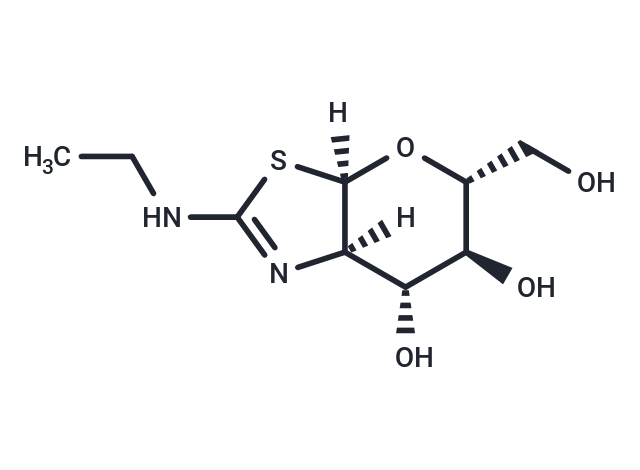Shopping Cart
- Remove All
 Your shopping cart is currently empty
Your shopping cart is currently empty

Thiamet G is a potent, selective O-GlcNAcase inhibitor with Kiof 21 nM, while exhibiting 37, 000-fold selectivity over human lysosomal –hexosaminidase.

| Pack Size | Price | Availability | Quantity |
|---|---|---|---|
| 2 mg | $37 | In Stock | |
| 5 mg | $57 | In Stock | |
| 10 mg | $94 | In Stock | |
| 25 mg | $198 | In Stock | |
| 50 mg | $361 | In Stock | |
| 100 mg | $537 | In Stock | |
| 500 mg | $1,190 | In Stock | |
| 1 mL x 10 mM (in DMSO) | $57 | In Stock |
| Description | Thiamet G is a potent, selective O-GlcNAcase inhibitor with Kiof 21 nM, while exhibiting 37, 000-fold selectivity over human lysosomal –hexosaminidase. |
| Targets&IC50 | O-GlcNAcase (OGA):21 nM(Ki) |
| In vitro | In NGF-differentiated PC-12 cells, inhibition of O-GlcNAcase by Thiamet G increases the cellular levels of O-GlcNAc with EC50 of approximately 30 nM. Thiamet G (100 mM) reduces tau phosphorylation by approximately 2.1-fold, 2.7-fold, 1.2-fold and 1.3-fold for Ser396, Thr231, Ser422 and Ser262, respectively. [1] Thiamet G (12.5 nM and 25 nM) significantly enhances p38 phosphorylation by increasing O-GlcNAcylation in mesangial cells. [2] In O-GlcNAc transferase or O-GlcNAcase gain of function cells, thiamet-G restores the assembly of the spindle and partially rescues histone phosphorylation. [3] |
| In vivo | In rats, thiamet G (50 mg/kg) administrated by i.v. crosses the blood brain barrier and then results in increase in brain O-GlcNAc levels in a dose- and time-dependent manner, and reduction of tau phosphorylation in rat brain. Thiamet G is also orally bioavailable. [1] O-GlcNAc accumulation induced by thiamet G stimulates chondrogenic differentiation in C57/bl mice by increasing the gene expression of differentiation markers, as well as the activity of MMP-2 and -9. [4] |
| Kinase Assay | All enzymatic assays are performed in triplicate at 37°C using 4-methylumbelliferyl N-acetyl-β-d-glucosaminide dehydrate as substrate. 1 nM of purified OGA is incubated with the compounds for 5 min, and then 0.2 mM of the substrate is added. The liberation of 4-methylumbellifery is monitored by kinetic reading at excitation/emission 355/460 nm using a Tecan M200 plate in a mode of 60 s/cycle and 15 cycles in total. |
| Cell Research | Jurkat cells are seeded at 6000 cells/well in a 96-well plate, and 12 h later, cells are treated with compounds for the indicated time. Cell viability is determined by XTT assay. |
| Alias | TMG |
| Molecular Weight | 248.3 |
| Formula | C9H16N2O4S |
| Cas No. | 1009816-48-1 |
| Smiles | [H][C@]12O[C@H](CO)[C@@H](O)[C@H](O)[C@@]1([H])N=C(NCC)S2 |
| Relative Density. | 1.74 g/cm3 (Predicted) |
| Storage | Powder: -20°C for 3 years | In solvent: -80°C for 1 year | Shipping with blue ice. | |||||||||||||||||||||||||||||||||||
| Solubility Information | H2O: 50 mg/mL (201.37 mM), Sonication is recommended. DMSO: 100 mg/mL (402.74 mM), Sonication is recommended. | |||||||||||||||||||||||||||||||||||
Solution Preparation Table | ||||||||||||||||||||||||||||||||||||
H2O/DMSO
| ||||||||||||||||||||||||||||||||||||

Copyright © 2015-2025 TargetMol Chemicals Inc. All Rights Reserved.